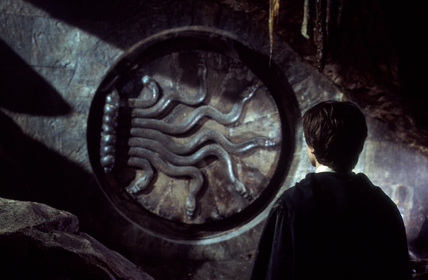Stilio
| Stilio zlacuru | |
| Spoken in: | All |
| Conworld: | Harry Potter |
| Total speakers: | est. < 10,000 |
| Genealogical classification: | a priori conlangs
|
| Basic word order: | VSO |
| Morphological type: | Fusional |
| Morphosyntactic alignment: | Active–stative |
| Writing system: | |
| Created by: | |
| Francis Nolan/Robert Marshall Murphy | 2002/2012 A.D. |
Parseltongue (in this article) refers to Stilio, a reconstructed form of Parseltongue. This language has a unique morphosyntactic alignment (which is largely Ergative-absolutive, while incorporating elements of Fluid-S), and defaults to VSO word order. It tends to be either double-marking or dependent marking. It is generally head-initial (right-branching).
- Phonology
- Concepts
- Morphology
- Syntax
- Word Order
- Relative Clauses
- Particles
- Texts
- From the Films
- Translations
- Lexicon
It is everyone involved's sincere desire that this project serve as an inspirational model for magical/muggle interactions in the future. Parseltongue is an excellent pattern to follow since it's existence is only known by magic but only muggles have developed the science of linguistics. This project is dedicated to the first martyr of this charitable cause, Charity Burbage, and the very kind Parselmouth Penelope Gaunt, without whose help none of this would have been possible.
History and Learning
Paracelsus (1493—1541), was an Austrian physician, born Phillip Von Hohenheim. On accident, he discovered he could speak to snakes. He had no explanation for the phenomenon and made no attempt to document its simple existence.
In the 1990's, the now-famous Harry Potter discovered that he was a Parselmouth (a wizard with the unconscious, magical ability to speak to snakes). He never learned any vocabulary or grammar, but was able to produce novel utterance, even with derived morphologies. He subsequently lost this magical ability. After the worldwide rediscovery of magic (hidden since 1692) and the creation of the Ministry of Muggle Relations, our department was given a grant to study Parseltongue and Parselmouths. To date, we have only found one conscious snake to interview, though communities of Parselmouths have been found in Estonia, Bukina-Fasa, and Sri Lanka.
On the one hand, Parseltongue is like any other language that human beings may study and learn. On the other hand, it is a magical ability possessed by only a minuscule fraction of the wizarding community. This ability requires no conscious attention by the wizard or witch, but seemingly adds a layer of "pseudo-consciousnes" to the snake with whom they are speaking. This snake is then able to articulate speech and hear the Parselmouth, both of which are otherwise physically impossible.
Parseltongue itself seems to be a magically generated amalgam created by magic from the minds of speakers. It bears many strong resemblances to languages from Africa and India, both areas with long histories of human-snake interaction. All over the world, Parselmouths, Snake-animagi, and sentient snake-like creatures all speak the same version of the language, without being in physical contact. The language is magically maintained among all speakers and updates itself, however slowly. In Sapir's terminology, there is only short-term unidirectional drift, not long-term cyclic drift. Given the small number of speakers, this drift is assumed to be very small and gradual. Dialects do not exist.
